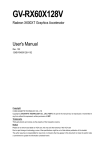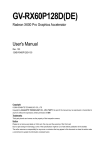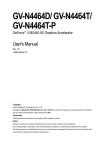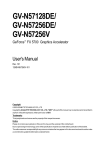Download Gigabyte Radeon 9600Pro AGP 128MB VGA DVI TV
Transcript
VGA Card
GV-R96P256D / GV-R96P128DE
Dec. 20, 2004
VGA Card
GV-R96P256D / GV-R96P128DE
Dec. 20, 2004
GV-R96P256D /
GV-R96P128DE
Radeon 9600 PRO Graphics Accelerator
User's Manual
Rev. 101
12MD-R96P256D-101
Copyright
© 2004 GIGABYTE TECHNOLOGY CO., LTD
Copyright by GIGA-BYTE TECHNOLOGY CO., LTD. ("GBT"). No part of this manual may be reproduced or transmitted in
any from without the expressed, written permission of GBT.
Trademarks
Third-party brands and names are the property of their respective owners.
Notice
Please do not remove any labels on VGA card, this may void the warranty of this VGA card
Due to rapid change in technology, some of the specifications might be out of date before publication of this booklet.
The author assumes no responsibility for any errors or omissions that may appear in this document nor does the author make
a commitment to update the information contained herein.
English
Table of Contents
1. Introduction ......................................................................................... 3
1.1. Features ..................................................................................................... 3
1.2. Minimum System Requirement .................................................................. 3
2. Hardware Installation ........................................................................... 4
2.1. Board Layout .............................................................................................. 4
2.2. Hardware Installation .................................................................................. 6
3. Software Installation ............................................................................ 8
3.1. Windows® XP Driver and Utilities Installation .............................................. 8
3.1.1. Operating System Requirement ....................................................................................... 8
3.1.2. DirectX Installation ............................................................................................................ 9
3.1.3. Driver Installation ............................................................................................................ 10
3.1.4. Utilities on Driver CD ...................................................................................................... 12
3.1.5. Taskbar Icon .................................................................................................................... 14
3.1.6. Display Properties pages ................................................................................................ 17
3.2. Windows® 2000 Driver Installation ............................................................ 29
4. Troubleshooting Tips ......................................................................... 30
5. Appendix ........................................................................................... 31
5.1. How to Reflash the BIOS .......................................................................... 31
5.1.1. Reflash BIOS in MS-DOS mode .................................................................................... 31
5.1.2. Reflash BIOS in Windows mode .................................................................................... 31
5.2. Resolutions and Color Depth Table (In Windows® XP) ............................. 32
GV-R96P256D/GV-R96P128DE Graphics Accelerator
-2-
English
1. Introduction
1.1. Features
•
•
•
•
•
•
•
•
Powered by ATI Radeon 9600 PRO Visual Processing Unit (VPU)
Supports AGP 8X
Integrated with 256MB DDR memory (Only for GV-R96P256D)
Integrated with 128MB DDR memory (Only for GV-R96P128DE)
Supports DirectX 9.0
Supports AV / S-Video output
Supports TV-Out and D-Sub connector
Supports DVI-I connector
1.2. Minimum System Requirement
•
•
•
•
•
•
IBM® or 100% PC compatible with Pentium® III 650MHz or AMD Athlon 650MHz
class processor or higher
One available AGP3.0 compliant slot or better
Operating Systems Windows® 2000 / Windows® XP
64MB system memory
50MB of available disk space for full installation
CD-ROM or DVD-ROM drive
-3-
Introduction
English
2. Hardware Installation
2.1. Board Layout
DVI-I Connector
TV-Out
VGA Monitor Connector
(15-pin)
DVI Output
Digital LCD Monitor
Analog LCD Monitor
VGA Output
DVI-I to D-Sub
Connector
DVI-I Connector
AV Output
TV-out
NTSC / PAL TV
S-VideoOutput
VGA Monitor
Connector
(15-pin)
Projector
OR
Analog LCD Monitor
VGA Output
Analog Monitor
GV-R96P256D/GV-R96P128DE Graphics Accelerator
-4-
DO NOT APPLY POWER TO YOUR SYSTEM IF IT HAS BEEN DAMAGED ON
THE CARD.
In order to ensure your graphics card working correctly, please use official
Gigabyte BIOS only. Use none official Gigabyte BIOS might cause problem
on the graphics card.
-5-
Hardware Installation
English
Expansion cards contain very delicate Integrated Circuit (IC) chips. To
protect them against damage from static electricity, you should follow
some precautions whenever you work on your computer.
1. Turn off your computer and unplug power supply.
2. Use a grounded wrist strap before handling computer components. If you do not
have one, touch both of your hands to a safely grounded object or to a metal object,
such as the power supply case.
3. Place components on a grounded antistatic pad or on the bag that came with the
components whenever the components are separated from the system.
The card contains sensitive electric components, which can be easily damaged by
static electricity, so the card should be left in its original packing until it is installed.
Unpacking and installation should be done on a grounded anti-static mat. The operator
should be wearing an anti-static wristband, grounded at the same point as the antistatic mat.
Inspect the card carton for obvious damage. Shipping and handling may cause damage
to your card. Be sure there are no shipping and handling damages on the card before
proceeding.
English
2.2. Hardware Installation
Installing Your Graphics card.
Now that you have prepared your computer, you are ready to install your graphics
accelerator card.
To install your graphics accelerator card:
1. Power off the computer and monitor, then
disconnect the display cable from the back
of your computer.
2. Remove the computer cover. If necessary,
consult your computer's manual for help
in removing the cover.
3. Remove any existing graphics card from
your computer.
Or, if your computer has any on-board
graphics capability, you may need to
disable it on the motherboard. For more
information, see you computer
documentation.
GV-R96P256D/GV-R96P128DE Graphics Accelerator
-6-
English
4. Locate the AGP slot. If necessary, remove
the metal cover from this slot; then align
your graphics card with the AGP slot, and
press it in firmly until the card is fully
seated.
5. Replace the screw to fasten the card in
place, and replace the computer cover.
6. Plug the display cable into your graphics
card; then turn on the computer and
monitor.
7-Pin for TV-out only
To Flat Panel Display
To VGA Monitor
You are now ready to proceed with the installation of the graphics card drivers. Please
refer to next chapter for detailed instructions.
-7-
Hardware Installation
English
3. Software Installation
In this manual, we assume that your CD-ROM Drive letter to be Drive D:
The installation of Windows® 2000 / Windows® XP drivers is very simple. When you insert
the driver CD into your CD-ROM drive, you can see the AUTORUN window (if it does not
show up, run "D:\setup.exe"). Then you can follow the guides to setup your graphics card
driver. (Please follow the subsection 3.1.3 "Driver installation" to install the driver for your
graphics accelerator.)
3.1. Windows® XP Driver and Utilities Installation
3.1.1. Operating System Requirement
• When loading the graphics card drivers for the system, please make sure your
system has installed DirectX 9 or later version.
• If you install the graphics card drivers for the motherboard, which consist of SIS, or
VIA chipsets, please install the appropriate driver program for that motherboard.
Or please contact your motherboard nearest dealer for motherboard driver.
GV-R96P256D/GV-R96P128DE Graphics Accelerator
-8-
Install Microsoft DirectX to enable 3D hardware acceleration support for Windows® 2000
or Windows® XP to achieve better 3D performence.
0 Note: For software MPEG support in Windows® 2000 or Windows® XP, you must
install DirectX first.
Step 1. When autorun window show up, click the
Install DirectX 9 item.
Click the Install DirectX 9 item.
Step 2. Choose I accept the agreement
and click the Next button.
Step 3. Click the Next button.
Installing the components.
Step 4. Click Finish to restart computer.
Then the DirectX 9 installation is completed.
-9-
Software Installation
English
3.1.2. DirectX Installation
English
3.1.3. Driver Installation
A. New hardware found
After the graphics card is inserted into your computer at the first time, the windows will
automatically detect a new hardware in the system and pop out a "New Hardware Found"
message. The following is the step-by-step installation guide.
Step 1: Found new hardware wizard: Video controller (VGA Compatible)
Click the Next button to install the driver. (There
is a driver CD disk that came with your graphics
accelerator, please insert it now.)
Or click the Cancel button to install the driver
from AUTORUN window.
Step 2: Found new hardware wizard: Searching and installing
The wizard will search for the driver and install it automatically.
Step 3: Found new hardware wizard: Finish
Click the Finish button to finish the installation.
GV-R96P256D/GV-R96P128DE Graphics Accelerator
- 10 -
Step 1. When autorun window show up, click the
Install Display Drivers (Radeon 9600 Series)
item.
Click the Install Display Drivers (Radeon
9600 Series) item.
Step 2. Click Next button.
Step 3. Click Yes button.
Setp 4. Click Express or Custom icon.
Windows installings the components.
Step 5. Click the Finish button to restart computer.
Then the driver installation is completed.
- 11 -
Software Installation
English
B. Driver installation (Autorun Window)
Insert the driver CD disk into your CD-ROM, and then you can see the AUTORUN window.
If it does not show up, please run "D:\setup.exe".
English
3.1.4. Utilities on Driver CD
Insert the driver CD disk into your CD-ROM, and then you can see the AUTORUN window.
If it does not show up, please run "D:\setup.exe".
z Install GIGABYTE Utility:
Click the GIGABYTE Utility item.
Step 2. Click the Next button.
Step 3. Enter your name and company.
Step 4. Click the Finish button to restart computer.
Then the GIGABYTE Utility installation is
completed.
GV-R96P256D/GV-R96P128DE Graphics Accelerator
- 12 -
English
z Install Hydravision :
Click the Hydravision Install item.
Step 2. Click the Next button.
Step 3. Click the Yes button.
Step 4. Click the Next button.
Windows installings the components.
Step 5. Click the Next button.
Step 6. Click the Finish button to restart computer.
Then the Hydravision installation is completed.
- 13 -
Software Installation
English
3.1.5. Taskbar Icon
After installation of the display drivers, you will find a GIGABYTE icon on the taskbar's
status area. Right-clicking this icon opens the GIGABYTE control panel, showing a menu
composed of shortcut of the graphics card's enhanced and other functions.
You may click the "Display Properties" item, and then click Settings. Click "Advanced"
after clicking Settings. Click the appropriate tab to change your display settings.
Right-click the icon.
Click the VGA Information
item into the "VGA Info" and
"Color Adjust" tabs.
You can link to GIGABYTE website for updated information about
the graphics accelerator, latest drivers, and other information.
GV-R96P256D/GV-R96P128DE Graphics Accelerator
- 14 -
English
VGA Information
VGA Info lists the relevant information about your card.
Color Adjust
Color Adjust allows you to make color adjustments, such as brightness, contrast and
gamma values for each or all of RGB colors.
- 15 -
Software Installation
ATI CATALYST Control Center:
English
TM
After installation of the display drivers, you will find an ATI CATALYST Control Center icon
on the taskbar's status area. The ATI CATALYST Control Center is used to configure all your
graphics card settings. Right-click the icon to enter the ATI CATALYST Control Center (refer to
Fig. 1). Or you can right-click on the desktop to select Properties>Settings>Advanced>ATI
CATALYST Control Center tab and press ATI CATALYST(tm) Control Center button (refer to Fig. 2).
TM
TM
TM
Fig. 1
Fig. 2
HYDRAVISION :
TM
HYDRAVISION has everything you need to manage increased amounts of information across
your computer desktop. It allows you to quickly and easily tailor your computer desktop to the way
you work. You can:
• arrange and rearrange monitors.
• assign Hot Key shortcuts.
• create up to 9 virtual desktops.
• add special effects to windows and menus.
You can right-click on ATI CATALYST Control Center icon
to select HYDRAVISION >
HYDRAVISION Properties to set the HYDRAVISION (refer to Fig. 3).
TM
TM
TM
Fig. 3
GV-R96P256D/GV-R96P128DE Graphics Accelerator
- 16 -
To access Display Properties pages, right-click the GIGABYTE icon on the taskbar and
select Display Properties or right-click on Desktop and then select Properties. The
Display Properties dialog box shows the information of display adapter, color, the range
of display area, and the refresh rate.
Settings (Resolutions and Color depth for Windows)
You may adjust the screen resolution and color quality settings in this dialog box.
You can move the slider to change the resolution.
You can click the item to change the color quality.
Click the Advanced button for adapter and setting.
Display
Matrix
Model
CRT+TV
CRT+DVI
DVI+TV
DVI+TV+CRT
GV-R96P256D
Yes
Yes
Yes
Yes
GV-R96P128DE
Yes
Yes
Yes
Yes
- 17 -
Software Installation
English
3.1.6. Display Properties pages
English
View Properties:
The CATALYST Control Center dashboard supports three types of views: Standard View/
Advanced View/ Custom View.
Standard View
The Standard view is the default view when
CATALYST Control Center is launched for the first
time. It provides a single button in the left navigation pane for each main page. The Standard view
is recommended for novice users.
Advanced View
The Advanced view provides access to the
advanced features on each page. The left
navigation pane displays a tree view that lists all
the advanced features. The Advanced view is
recommended for experienced users.
Custom View
The Custom view allows you to display only the
features you choose in the left navigation pane.
The Custom view is recommended for
experienced users who want to expose only the
features they adjust most often or that their 3D
application supports.
Hotkeys Properties:
The Hotkeys Manager allows you to create shortcut key combinations to quickly perform tasks
such as changing a graphics setting or opening an application. A Hotkey is a combination of a
modifier key or keys, such as Ctrl, Alt, or Shift, and any letter from the alphabet.
GV-R96P256D/GV-R96P128DE Graphics Accelerator
- 18 -
You can use profiles to create customized environments for your desktop, video, and 3D
applications. Define and save your own personal video settings that can be quickly activated
manually, through a Hotkey, or by file association.
Note:
A profile applies to a specific graphics
card. If there is more than one graphics
card installed in your computer, you
need to select the appropriate card
before creating, loading, or activating a
Profile.
Preferences Properties:
The Preferences page helps to restore defaults, change skins, and update the CATALYST Control
Center. The CATALYST Control Center Preferences page contains the following options:
- 19 -
Always on Top
Hide Tooltips
Hide Toolbar Text
Enable System Tray menu
Select a Language ...
Select a Skin ...
Restore Factory Defaults ...
Software Installation
English
Profiles Properties:
English
Help Properties:
The CATALYST Control Center Help feature allows you to access the comprehensive online help,
register your product, or generate a problem report should you require technical support.
The CATALYST Control Center Help feature offers the following options:
Help Contents ...
Search Help ...
Go to ATI.com
Information Center ...
About CATALYST Control Center ...
Information Center
The Information Center provides detailed information in one location about the installed graphics
hardware, graphics software, system hardware, and system software.
The System Software tab includes information such as the installed versions of Windows and Microsoft
DirectX.
The System Hardware tab includes information such as the installed CPU type and speed, the installed
BIOS and version, and the installed motherboard chipset.
The Graphics Software tab includes information such as installed 2D and 3D driver versions and OpenGL
version.
The Graphics Hardware tab includes information such as the installed graphics ID, bus type, and BIOS
version.
GV-R96P256D/GV-R96P128DE Graphics Accelerator
- 20 -
Display Manager Standard View
Use Display Manager Standard View to set
your desktop resolution, arrange your
displays, enable secondary devices such as
a TV, or use the Wizard to help you
configure your display(s).
Displays Manager Advanced View
Use Display Manager Advanced View to set
your desktop resolution, the display refresh
rate, and arrange your displays.
- 21 -
Software Installation
English
Display Manager :
English
3D :
3D Standard View
You can use 3D settings to adjust features
found in such 3D applications as graphicdesign and CAD programs and games.
This page is useful when you are not aware
of which type of 3D settings your application
uses, or when you want to use an overall
adjustment control that rapidly configures
your application.
Standard Settings
The Standard settings page provides access
to a universal slider control where you can
simultaneously adjust all of the standard 3D
settings for any type of 3D application. The
slider enables you to adjust for overall
system performance, overall 3D image
quality, or a balance between the two.
GV-R96P256D/GV-R96P128DE Graphics Accelerator
- 22 -
Anti-Aliasing is a technique used to smooth out
the jagged edges of three-dimensional curved
objects or objects with diagonal edges.
Anti-aliasing can be set to favor either an increase
in system processing performance or improved
image quality:
Setting for performance is best used when the 3D
image is animated and smoothness of motion is
the most important consideration.
Setting for quality is best used when having highly
detailed and realistic 3D objects is the primary
concern.
If you are unsure of how to configure anti-aliasing,
use the Let the Application Decide option. Your
display will automatically adjust to the application's
requirements.
Anisotropic Filtering
Anisotropic filtering is a technique that preserves
detail on surfaces that have three-dimensional
perspective and fade away into the background.
It works best when used in conjunction with
Mipmapping.
Anisotropic filtering can be set to favor either an
increase in system processing performance or
improved image quality:
Setting for performance is best used with applications that display objects with smooth, simple
surfaces, like those seen in CAD applications.
Setting for quality is best used with applications
that display highly detailed scenes, backgrounds,
and textured objects, like those seen in 3D games.
If you are unsure how to configure anisotropic
filtering, use the Let the Application Decide option.
Your display will automatically adjust to the
application's requirements.
- 23 -
Software Installation
English
Anti-Aliasing
English
Texture Preference
Use Texture Preference to chose the level of
quality and realism for the textured surface of 3D
objects.
Texture Preference can be set to favor either an
increase in system processing performance or
improved image quality:
Setting for performance is best used with applications that display objects with uniform and
smooth surfaces, such as a plain wall, floor, or
tabletop.
Setting for quality is best used with applications
that display objects or surfaces that are highly
detailed in their surface texture, such as frosted
glass, wood, speckled marble, or patterned
carpeting.
Mipmap Detail Level
Mipmapping is a texturing technique that preserves the detail on a 3D object’s surface as it
moves into the background. A series of low- and
high-resolution texture maps are stored in memory
and selectively used to create the object’s surface,
depending on what level of detail is needed.
Mipmap detail level can be set to favor either an
increase in system processing performance or
improved image quality:
Setting for performance is best used when the 3D
image is animated and smoothness of motion is
the most important consideration.
Setting for quality is best used when high surface
detail is required, especially if the animated
object rotates or moves into the background.
GV-R96P256D/GV-R96P128DE Graphics Accelerator
- 24 -
TRUFORM is a technology developed by ATI that
overcomes the bandwidth and memory constraints
of traditional 3D rendering software to produce
the smoothest and most natural 3D images.
TRUFORM not only enhances the smoothness,
but also provides highly detailed lighting effects.
This greatly enhances the realistic quality of 3D
scenes by providing highlights on the surface of
curved objects.
TRUFORM can be set to favor either an increase
in system processing performance or improved
image quality.
Setting for performance is best used for 3D
images that do not require a high level of smoothness and lighting detail.
Setting for performance is best used for situations
where a high level of realism is required for the
object's shape and reflective properties.
SMARTSHADERTM
SMARTSHADER technology incorporates major
advances in the area of Pixel Shaders, which are
small programs that execute on every pixel
rendered to the display device. With support for
up to six textures in a single rendering pass, the
memory bandwidth constraints associated with
multi-pass rendering can be greatly reduced,
which translates into better rendering
performance. By doubling the maximum allowable
length of the shader programs, more complex
effects can be created to accurately model the
visual properties of materials and surfaces,
including hair, skin, wood, and water.
- 25 -
Software Installation
English
TRUFORMTM
English
No Preview
The No Preview page combines all of the
principal 3D features onto a single page, without
any preview window, allowing for quick access and
adjustment. You can change the settings for the
following 3D features as you normally would on
each feature own page:
• Anti-aliasing
• Anisotropic filtering
• Texture Preference
• Mipmap detail level
• TRUFORMTM
• Wait for display refresh
• SMARTSHADERTM effects
This page is useful when it is not necessary to
preview the adjusted settings because the effect
is already known or understood.
API-Specific
The 3D API-Specific dialog helps to select
settings that are exclusively for the Direct3D® and
OpenGL® Application Programmable Interfaces
(API). These settings are provided for resolving
certain incompatibilities within 3D applications that
use one of these APIs.
Use this dialog when you are know which type of
API (Direct3D® or OpenGL®) your 3D application
uses, and you want to select a particular APIspecific feature.
If you are not sure which API your 3D application
uses, consult the documentation of your 3D
application.
GV-R96P256D/GV-R96P128DE Graphics Accelerator
- 26 -
The Color page helps to adjust the color properties of your Desktop and Full Screen 3D applications and games. Use the Color Correction Images to e preview the changes before applying
them. The Color curve is a graphical representation of all the values of gamma, brightness, or
contrast. The color curve line will reflect any changes made to these elements.
Color Desktop
Adjust the overall richness of color by using the
Gamma control. To adjust the overall brightness
use the Brightness control, and the overall
contrast use the Contrast control.
Color - Full-screen 3D
Adjusting the Gamma control alters the overall
richness of color. Adjusting the Brightness control
alters the overall brightness. Adjusting the
Contrast control alters the overall contrast.
Adjusting the Gamma can be useful for CAD
applications that rely heavily on color coding or
applications that require realistic color.
Adjusting the Brightness and Contrast can be
useful for 3D games that display dimly lit scenes.
Video :
With Video setting you can set for viewing video files:
Standard Settings
Video Overlay Standard Settings offers video presets that are comprised of Home, Work, Theater,
and Custom. Select a preset from the Video Presets drop down menu.
Overlay/VIDEOVISION
Use this page to manually set Gamma, Brightness,
Contrast, Saturation, and Hue.
Theater Mode
Use Theater Mode to change the way you view
streaming video.
- 27 -
Software Installation
English
Color :
English
SMARTGARTTM :
SMARTGARTTM is a software testing and diagnostics tool that performs a variety of AGP bus tests
in order to determine the optimal settings for your graphics card to ensure system stability. The
tests are run automatically when the computer is turned on; if your computer is functioning normally,
you do not need to adjust anything.
You can manually adjust the AGP bus settings
to meet the individual requirements of your
computer. Once you have made the changes you
can retest SMARTGARTTM by using the "Restest
All" button.
Note: Changing these settings could result in
system instability.
VPU Recover :
VPU Recover enables the ATI display driver to detect when the graphics processor stops
responding to display-driver instructions. When this happens, the display driver attempts to reset
the graphics hardware. In most cases, VPU Recover will be able to reset the graphics processor
without requiring a system restart.
Should the computer be unable to recover from a crash, VPU Recover will switch the computer to
software rendering mode, allowing you to save any work in progress before restarting the computer.
Enable VPU Recover
Prepare an error report if VPU Recover is
activated, for submission to ATI Technologies.
Allows the VPU Recover, once it is activated, to
generate an error report that you can send to ATI
via e-mail.
GV-R96P256D/GV-R96P128DE Graphics Accelerator
- 28 -
With Windows running on your computer, you need to install the graphics card driver to
take advantage of the higher performance, resolutions, and special graphics features of
the graphics card. To ensure you install the latest driver, insert the Installation CD that
shipped with your graphics card.
To install the graphics card driver for Windows® 2000, please insert the Installation CD.
Then the AUTORUN window will show up. Click Install Display Driver item, and follow
the wizard to install the driver.
If Windows® does not show the CD automatically, please run following steps:
1. Click the Start button on the control bar.
2. Select Run.
3. Type the following: D:\SETUP.exe
(If D is not your CD-ROM drive, substitute D with the correct drive letter.)
4. Click OK.
5. Click on Install Display Drivers to begin the Installation Wizard.
6. Click Next.
7. Click Yes to the license agreement.
8. Follow the Wizard's on-screen instructions to complete the installation.
Please make sure the Windows® 2000 have installed Windows® 2000 Service
Pack (or later) before installing the graphics accelerator driver.
- 29 -
Software Installation
English
3.2. Windows® 2000 Driver Installation
English
4. Troubleshooting Tips
The following troubleshooting tips may help if you experience problems. Contact your
dealer or GIGABYTE for more advanced troubleshooting information.
Check that the card is seated properly in the AGP slot.
Ensure that the display cable is securely fastened to the card's display connector.
Make sure that the monitor and computer are plugged in and receiving power.
If necessary, disable any built-in graphics capabilities on your motherboard. For
more information, consult your computer's manual or manufacturer.
(NOTE: Some manufacturers do not allow the built-in graphics to be disabled or to
become the secondary display.)
Make sure you selected the appropriate display device and graphics card when
you installed the graphics driver.
Restart your computer.
Press the F8 key on your keyboard after system starts up. When the Windows
Advanced Options Menu appears, select Safe Mode and press Enter.
After getting into Safe Mode, in Device Manager check whether the driver for the
graphics card is correct.
For more assistance, use the Troubleshooting Guide located in the Windows® Help
or contact your computer manufacturer.
If necessary, adjust your monitor's setting by monitor's adjust panel to make the
screen looks focused, crisp, and sharp. (Please refer to the monitor's manual.)
GV-R96P256D/GV-R96P128DE Graphics Accelerator
- 30 -
English
5. Appendix
5.1. How to Reflash the BIOS
5.1.1. Reflash BIOS in MS-DOS mode
1. Extract the downloaded Zip file to your hard disk or floppy disk. This procedure assumes drive
A.
2. Restart the computer in MS-DOS mode. (For Windows 2000/XP, you need a startup disk to
restart the computer in MS-DOS mode.)
3. Change the command prompt to A:\>.
4. At the A:\> prompt, type[BIOS flash utility name] -p 0 [BIOS file
name](example: atiflash -p 0 r955128d.f2) and press Enter.
5. Wait until it's done, then restart your computer.
5.1.2. Reflash BIOS in Windows mode
1. After installing the display drivers, you will find a GIGABYTE
icon in the lower-right corner
of the Taskbar. Right-click to select the @VGA utility.
@VGA flash BIOS utility.
2. Update BIOS through the Internet
a. Select the Live Update check box and click Flash. Then @VGA will automatically download
the BIOS for your card from GIGABYTE @VGA server and do the update for you. (@VGA
will not download/update the BIOS if it detects the current BIOS on your card is the latest
one.)
3. Update BIOS NOT through the Internet
a. Download the BIOS ZIP file for your card from GIGABYTE website and extract it to your
hard disk (or floppy disk).
b. Select the From Local File check box and then click Flash.
c. Select the BIOS file from your hard disk (or floppy disk).
d. Complete the update procedure following the on-screen instructions.
- 31 -
Appendix
English
5.2. Resolutions and Color Depth Table (In Windows® XP)
Radeon 9600 PRO 2D Single Display Modes
Display
Screen
Resolution
640 x 480
800 x 600
1024 x 768
1152 x 864
1280 x 768
1280 x 960
1280 x 1024
1600 x 1200
1792 x 1344
1800 x 1440
1856 x 1392
1920 x 1080
1920 x 1200
1920 x 1440
2048 x 1536
Maximum
Refresh Rate
(Hz)
200
200
200
100
85
160
120
100
85
70
75
75
85
75
66
Color Depth (bpp)
8bpp(256 color)
Standard mode
3
3
3
3
3
3
3
3
3
3
3
3
3
3
3
16bpp(65K color)
High mode
3
3
3
3
3
3
3
3
3
3
3
3
3
3
3
32bpp(16.7M)
True mode
3
3
3
3
3
3
3
3
3
3
3
3
3
3
3
* The table is for reference only. The actual resolutions supported depend on the monitor you use.
GV-R96P256D/GV-R96P128DE Graphics Accelerator
- 32 -
English
- 33 -
Appendix
English
GV-R96P256D/GV-R96P128DE Graphics Accelerator
- 34 -

























































